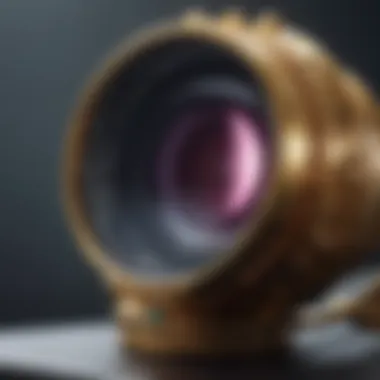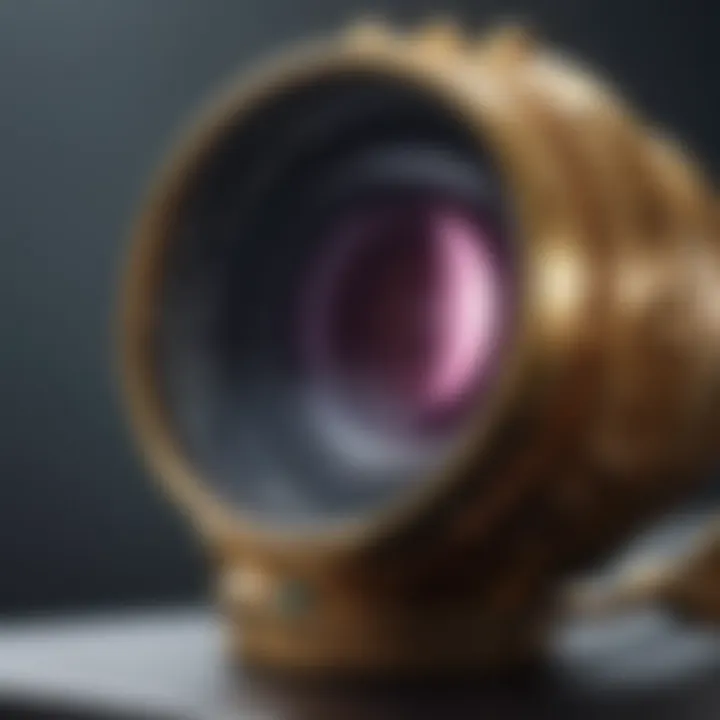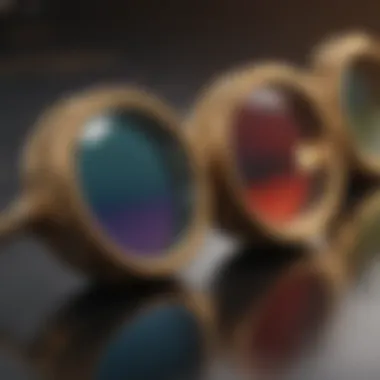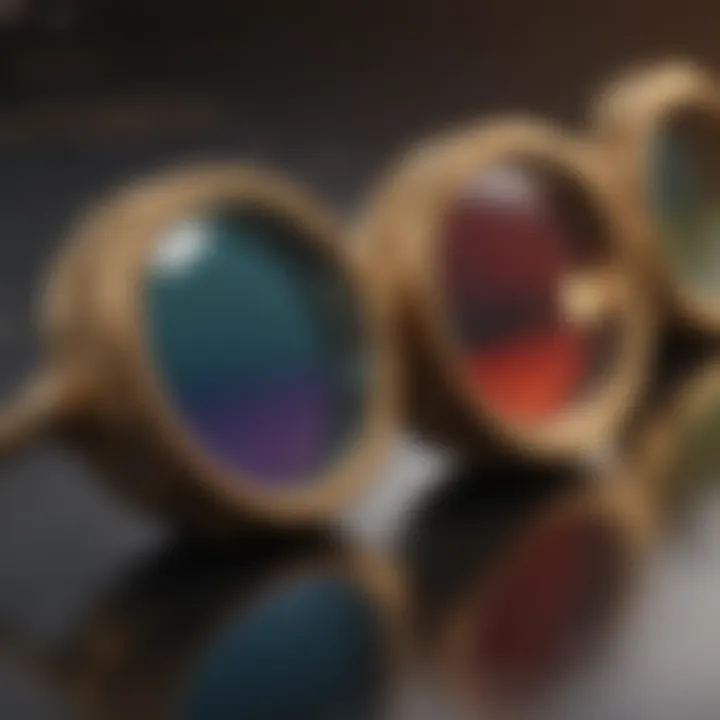Understanding the Jeweler's Eye Loupe: A Deep Dive


Intro
The jeweler's eye loupe serves as the unsung hero in the world of gemology and jewelry making. Often overshadowed by more prominent tools, this small yet powerful magnifying instrument holds the key to accurately assessing gemstones. As we embark on this exploration, we will unravel not only its essential attributes but also delve into its historical significance and evolving technology.
Understanding the loupe is more than just recognizing it as an accessory; it's about appreciating its role in evaluating the beauty, quality, and authenticity of gems that have captivated our hearts for centuries. Whether you're a seasoned gemologist or a hobbyist captivated by the shiny allure of gemstones, grasping the nuances of this tool can enhance your experience and understanding.
Gemstone Overview
Definition and Characteristics
At its core, a gemstone is a portion of mineral crystal, or alternatively a rock, that has been cut and polished to be used in jewelry or other decorative items. Gemstones are often revered for their rarity, brilliance, and beauty. They possess unique characteristics which can be delineated in various ways:
- Color: This is often the most identifiable trait of a gemstone, influencing its desirability and price.
- Clarity: Refers to the level of inclusions or imperfections in the stone. A clearer stone is typically more valuable.
- Cut: The design of a gemstone plays a crucial role in its overall allure. An expert cut can significantly enhance a stone's brilliance.
- Carat Weight: Larger stones are generally more valuable, though this can depend on the other characteristics as well.
Classification of Gemstones
Gemstones can be broadly categorized into two distinct groups: precious gemstones and semi-precious gemstones. Each type has its unique appeal and value.
- Precious Gemstones: These include diamonds, rubies, sapphires, and emeralds. Their rarity and splendid attributes often command higher prices.
- Semi-Precious Gemstones: This classification features a broader range of stones such as amethyst, garnet, and topaz. While they may not carry the same price tag as precious gems, they are equally captivating and often favored for their variety and color.
In essence, the loupe serves as a window into these mesmerizing worlds of color and clarity, allowing gem enthusiasts to scrutinize the minute details that differentiate one stone from another.
Historical Significance
Ancient Uses and Cultural Importance
The history of gemstones is as rich as the stones themselves. Civilizations such as the Egyptians, Greeks, and Romans placed significant cultural importance on these natural wonders. Loupes or similar magnifying tools, though less sophisticated, have been used in different forms to examine the quality of gemstones since antiquity.
Myths and Legends Surrounding Gemstones
The stories surrounding gemstones are woven into the fabric of different cultures. For example, some believe that sapphires protect against envy, while rubies are seen as symbols of passion and life. These legends have added layers of meaning to the stones, making them more than just eye-catching accessories; they’re vessels of history and belief.
"The true beauty of a gemstone lies not only in its physical attributes but also in the stories it carries through time."
Understanding these tales can undoubtedly augment one’s appreciation of gems and, by extension, the tools, like the loupe, that enable us to discern their beauty.It is crucial to approach the subject with an informed perspective, recognizing the interplay between the physical and cultural significance of the gems we so adore.
Intro to the Jewelers Eye Loupe
To truly appreciate the beauty and intricacy of gemstones, one needs to look beyond the surface. This is where the jeweler's eye loupe shines, bringing the unseen details into clear focus. This small yet powerful tool is indispensable for both gemologists and jewelry makers. By enhancing the ability to scrutinize gemstones closely, loupes help in making informed decisions regarding authenticity, quality, and value.
Definition and Purpose
A jeweler's eye loupe is a magnifying device used primarily in the fields of gemology and jewelry making. Typically, it's a small, handheld lens mounted in a metal or plastic casing. The purpose of a loupe is not merely to magnify but to reveal the textural nuances that lie within gemstones and precious metals. By utilizing various magnification strengths, jewelers can inspect stones for inclusions, determine their quality, and even evaluate craftsmanship.
Additionally, the ability to analyze fine details can play a pivotal role in assessing the overall worth of a gemstone. Whether you're evaluating a diamond for purchase or examining antique jewelry for restoration, having a loupe handy is akin to having a paintbrush in the hands of an artist—essential for revealing the masterpiece within.
Historical Background
The roots of the jeweler's eye loupe extend deep into history, with its origins often traced back to the 19th century. Early gemologists relied on simple magnifying glasses that were bulky and cumbersome. Craftsmen began to realize that a more portable solution was needed, paving the way for loupes to take center stage.
By the time the 20th century rolled around, advancements in optical technology had revolutionized the market. Different designs and innovations emerged, such as the introduction of lenses made from various materials to enhance clarity and reduce distortion. Many jewelers today use specialized loupes equipped with LED lights, allowing them to work in low-light conditions more effectively.
The evolution of the jeweler's eye loupe reflects a significant shift in the approach to gemstone examination. It also highlights how essential these tools became in transforming the art of jewelry making and gemology from a simple craft to a detailed science.
When a jeweler peers through a loupe, they are not just looking—they are uncovering stories etched in every facet of a gemstone.
Types of Jewelers Eye Loupes
Understanding the variety of jewelers eye loupes available is essential for anyone serious about gemology. Each type serves a unique purpose and offers distinct advantages, thus catering to different needs and preferences of gemstone enthusiasts, collectors, and professionals alike. The right loupe can enhance the experience of examining gems, enabling users to see beyond the surface and catch intricate details. This section dives into the important elements and characteristics of the various types of loupes, focusing on magnification levels, lens types, and lighting options.
Magnification Levels


Low Power Magnification
Low power magnification typically ranges from 2x to 4x, making it a popular choice for a first look at a gemstone. The main contribution of low power magnification is that it allows users to examine larger areas of a gem all at once, making it easier to spot surface irregularities and overall symmetry. One of the key characteristics of low power loupes is their ability to provide a wider field of view. This feature is especially beneficial when assessing larger stones or lots with multiple gems. Though it may not reveal finer details like inclusions or minor scratches, it's perfect for getting a general sense of a stone's quality.
One unique advantage here is the reduction in fatigue; lower magnification tends to be easier on the eyes during extended use. However, the trade-off is the inability to spot very subtle flaws, so it's often recommended to use low power loupes as an initial assessment tool.
High Power Magnification
High power magnification offers levels from 10x up to 30x and even beyond, making these loupes tailored for professionals who require a closer inspection. The contribution of high power magnification is notable when it comes to identifying specific flaws like inclusions, color zoning, and tiny scratches that would otherwise go unnoticed at lower magnifications. The key characteristic here is the depth of detail that one can observe.
While high power loupes are beneficial for critical assessments, they come with their own set of challenges. The field of view becomes considerably narrower, which can lead to eye strain if used for long durations. Additionally, the higher magnification often magnifies any hand movement, making it harder to maintain a steady image. Therefore, while high power loupes are invaluable in specific scenarios, they are typically best used in conjunction with lower magnification options to provide a well-rounded inspection.
Lens Types
Monocular Loupes
Monocular loupes feature a single lens, offering a compact design that is typically more lightweight than their binocular counterparts. Their contribution to the overall functionality lies in their simplicity; they are a favored choice for many jewelers and gemologists because they can be easily carried around. A key characteristic of monocular loupes is their affordability. They typically come at a lower price point, making them accessible to beginners and hobbyists alike.
The unique feature of a monocular loupe is its straightforward usability. Users only have to focus with one eye, allowing for a quick examination. However, the downside is that monocular loupes don’t provide the same depth perception as binocular options, which can make evaluating gem dimensions a bit tricky.
Binocular Loupes
Binocular loupes, with their dual lenses, are designed to offer a more immersive viewing experience. Their contribution is particularly significant when it comes to depth perception; the two lenses work together to provide three-dimensional imagery. This feature can be crucial for more complex evaluations where the nuances of stone cut and clarity matter.
What makes binocular loupes a popular choice among professionals is their enhanced comfort during prolonged use. They also reduce eye strain, allowing users to enjoy clearer views. However, the trade-off often includes a heftier price tag, which might not make them the first choice for every beginner in the field.
Lighting Options
Natural Light
Using natural light for examination has its merits; it provides an unfiltered view of a gemstone's appearance. The contribution of natural light to gem inspection is significant, as it allows one to see the gem as it would appear under regular lighting conditions. A key characteristic of natural light is its ability to reveal the stone's color and inclusions in a more authentic manner. It's akin to having a well-lit view of your surroundings.
The unique advantage here is that it offers a perspective of the gem's innate beauty. However, the main disadvantage is that natural light can be inconsistent, which may lead to ambiguity in evaluation during different times of the day or varying weather conditions.
LED Illumination
LED illumination offers a controlled source of light, making it an excellent alternative or supplement to natural light. Its contribution to gemology is manifest in its ability to highlight inclusions and details under various light conditions without introducing any color distortion. The key characteristic of LED light is its intensity and adjustability, allowing users to modify the lighting based on the specific attributes of the gem they are evaluating.
The unique feature of LED illumination is that it can be engineered to mimic natural light or focus on specific wavelengths that reveal fluorescence. However, one must be cautious with LED lights, as overly bright illumination can sometimes wash out the subtle hues in a gemstone, making it imperative to use them thoughtfully during an examination.
Mechanics of the Jewelers Eye Loupe
Understanding the mechanics behind a jeweler's eye loupe is essential for anyone seriously looking into gemology or jewelry making. This section dives into two critical aspects: the optical design which allows a clear view of gemstones, and the materials used in manufacturing these compact yet powerful tools. Each element contributes to how effectively a loupe performs its intended function, directly impacting the user’s ability to assess gemstones accurately.
Optical Design
The optical design of a jeweler's eye loupe greatly influences not just the clarity of the image but also user comfort during extended use. Generally, loupes are composed of a simple lens arrangement that magnifies objects while maintaining a good field of view. The typical design involves a convex lens—sometimes multi-element—crafted specifically for gemology.
The arrangement of these lenses determines the level of distortion, which can be critical when assessing the natural appearance of a gemstone. A well-designed loupe minimizes optical aberrations, allowing for a more faithful representation of colors and inclusions.
Key elements to consider in optical design include:
- Type of lens: Single vs. doublets tend to affect performance.
- Diameter of the lens: Larger lenses often provide a better field of view.
- Curvature: Impacts how the loupe corrects distortion.
A good optical design translates to clearer and more detailed images of the gemstones, which is paramount for gemologists and collectors alike. A crystal clear view means that any subtle features, like minor inclusions or color zoning, can be identified more easily.
Materials Used
The materials used in the construction of a jeweler's eye loupe can heavily influence both the durability and performance of the device. In most cases, the housing is made from lightweight metals or high-quality plastics, which helps reduce overall weight while providing sturdiness. Glass is typically used for the lens itself, as it offers better clarity compared to plastic lenses, though some high-end options employ specialized optical-grade glass.
Some important considerations regarding materials include:


- Durability: A metal housing is often more resilient than plastic, sustaining wear and tear over time.
- Weight: Lighter materials enhance portability without sacrificing functionality.
- Optical quality: Higher-grade lenses can significantly increase clarity and reduce glare.
"The right combination of materials not only affects how the loupe looks but, more importantly, its performance in the field."
Taking care to choose the right materials can enhance the user experience; a robust yet lightweight loupe ensures comfort during long examinations while providing reliable performance. In the end, understanding how optical design and material choice interplay can make all the difference in the quality of gemstone evaluation.
Applications in Gemology
The jeweler's eye loupe plays a pivotal role in the practice of gemology. Essentially, it allows both professionals and amateurs to scrutinize gemstones with remarkable clarity. Let’s dive into this aspect of gemology, assessing how this small yet mighty tool enhances the experience and importance surrounding gem analysis.
Examining Gemstones
When it comes to examining gemstones, clarity and detail are paramount. A jeweler's eye loupe offers close-up views that reveal the true nature of the stone. For example, a 10x magnification can help identify a gemstone’s color saturation, brilliance, and transparency. This level of detail is crucial when distinguishing between different types of stones. A simple glance can’t provide the insights that a loupe can, especially in a vast market filled with simulants.
In practical scenarios, gemologists routinely employ loupes to inspect the surface of a stone. They look for scratches, abrasions, or any other signs of treatment. Without the loupe, many of these defects would remain hidden, leading to misjudgments concerning the value and authenticity of the gemstone.
Identifying Flaws and Inclusions
Flaws and inclusions are not just blemishes; they tell a story about the gemstone. Loupes provide a gateway to understanding these characteristics. While some inclusions can lower a stone’s value, other features—like a unique inclusion—can actually enhance it.
For instance, when examining a diamond with a jeweler's loupe, you might encounter a feather-shaped inclusion. This could indicate how the diamond formed and reveal its history. On the other hand, a loupe can also help in spotting treatments that may artificially improve a gemstone’s appearance, leading to potential ethical concerns or misrepresentations in sales.
Using a loupe is thus not just about looking; it's about understanding the journey a gemstone has taken. With accurate evaluations, gemologists can provide informed assessments, effectively guiding buyers in their collection choices.
Evaluating Gemstone Quality
The quality of a gemstone is assessed across various parameters, and here the loupe shines brighter than a diamond. Using optical instruments allows the evaluator to measure cut, color, clarity, and carat weight—often referred to as the "Four Cs" of gemstones—more precisely.
While numerous factors influence a stone's pricing, clarity ranks high. Many clients may overlook minor inclusions or surface blemishes without the aid of a loupe. However, experienced jewelers will highlight these blemishes, ensuring that consumers make educated decisions.
Furthermore, a loupe helps in eliminating potential counterfeits by verifying whether a stone meets the established standards in the industry. For gem enthusiasts, knowing how to evaluate a gemstone with a loupe not only enhances their understanding but also fuels their appreciation for these natural treasures.
"A true gemologist serves as a bridge, connecting the beauty of a stone to its story through meticulous analysis."
In summary, the jeweler's eye loupe proves to be indispensable in gemology, enhancing the capability to examine gemstones, identify their flaws, and evaluate their overall quality. Its significance cannot be overstated—it provides an essential service in the quest for knowledge, appreciation, and confidence in the world of gemstones.
Choosing the Right Loupe
Selecting the right jeweler's eye loupe is not just a matter of preference; it can make or break your gemstone evaluation experience. For both amateur enthusiasts and seasoned professionals, the loupe serves as an indispensable tool. Choosing wisely can enhance not only the precision of your assessments but also your overall satisfaction with the gear you use. You wouldn’t want to drive a Ferrari on a dirt road, would you? Similarly, understanding how to make this choice offers a clearer path to achieving the desired outcomes when examining gems.
Factors to Consider
Budget
When contemplating a loupe, the budget is often the first checkpoint on the buying journey. While some might bristle at the thought of spending a chunk of change on a small tool, the reality is that a quality loupe can save you money in the long run. Higher-priced loupes often use superior optics and materials that significantly improve clarity and magnification capabilities.
In the world of jewelry, the difference between an average loupe and a premium one can be as stark as night and day.
- Key Characteristic: Longevity and clarity often correlate with the price point.
- Benefit: Investing in a quality loupe can prevent missed flaws that could affect a gemstone's value, ultimately safeguarding your financial interests.
On the flip side, it’s wise to be cautious of brands that charge exorbitantly without providing value in terms of performance. You might find some reasonably priced options, like those from BelOMO, to be surprisingly effective without breaking the bank.
Purpose of Use
Diving into the purpose of use allows you to narrow down your loupe choices significantly. If you're primarily examining diamonds, you might need a loupe with specific features, like a high magnification level and exceptional clarity. On the other hand, if you’re only dabbling in casual gemstone collecting, a more affordable model could suit you well.
- Key Characteristic: Tailoring your loupe choice to fit your specific needs gives you the best shot at making informed decisions about gemstone quality.
- Benefit: A loupe designed for specific applications will help in pinpointing imperfections, allowing for a more precise evaluation.
Each application can come with its unique challenges, too. For instance, if you're investigating inclusions in opals, a lower magnification might suffice. Yet, if your focus is on checking the brilliance of a top-quality diamond, you might want to go for high magnification combined with bright lighting. Be aware that choosing a loupe without consideration for its intended use could lead to frustration down the road.
Recommended Brands
When it comes to specific brands that stand out in the crowded loupe market, a few names have built a solid reputation based on their offering:


- GemOro: Known for their comprehensive range of loupes catering to both amateurs and professionals. They often combine functionality with affordability.
- Hastings: A staple among gemologists, their products are famed for durability and clarity that allow you to see every pinprick and fault.
- BelOMO: Offering surprisingly clear optics at budget-friendly prices, their loupes can serve as a great starting point for beginners.
While there are many other brands out there to scout for, these names come with proven reliability and quality, making them worthy of your consideration as you embark on the journey of examining the glimmering world of gemstones.
Remember, making an informed choice doesn't just improve your experience; it can also help you refine your skills and appreciate the finer details that gemstones have to offer.
By understanding the factors that come into play when choosing a loupe, you set yourself up for success in both your evaluations and enjoyment of the gemological arts.
Maintenance and Care of the Eye Loupe
Caring for your jeweler's eye loupe is of paramount importance, as this magnification tool is not just an accessory, but a crucial instrument for gemstone evaluation. Proper maintenance extends the longevity of the loupe and ensures that the clarity and precision of your magnified view remain uncompromised. It’s akin to keeping a sharp knife in the kitchen; without regular upkeep, it becomes ineffective and can even lead to mishaps. With that in mind, let’s delve into the essentials of keeping your loupe in tip-top shape.
Cleaning Techniques
When it comes to cleaning your eye loupe, there are best practices to follow that ensure you maintain its performance without causing accidental damage. Keeping the lenses free from smudges and dust is vital to achieve clear images of your gemstones.
- Use a Blower: Start with a gentle air blower to remove any loose dirt or debris. This step is important to avoid scratching the lenses during the more invasive cleaning methods.
- Microfiber Cloths: For any spots or fingerprints, a soft microfiber cloth is your best friend. Unlike paper towels, which may scratch the surface, microfiber is gentle and effective.
- Lens Cleaner: If fingerprints persist, use a small amount of lens cleaning solution on the cloth (never directly on the lens) and wipe in a circular motion. This helps maintain the optical integrity of the loupe while ensuring thorough cleaning.
- Avoid Harsh Chemicals: Always steer clear of window cleaners or household chemicals as these can damage the lens coatings.
- Regular Checks: Lastly, make a habit of inspecting your loupe regularly. If you notice any significant dirt build-up or scratches, it might be time for a professional check-up.
Storage Solutions
Proper storage of your eye loupe is equally as crucial as cleaning. Where and how you keep it can affect its performance when you need it most. Here are a few tips to consider when storing your loupe:
- Protective Cases: Whenever the loupe is not in use, keep it in a padded case or a holder. This can protect it from accidental drops and environmental factors.
- Away from Moisture: Avoid storing your loupe in damp places, as moisture can lead to fogging, mold, or degradation of materials over time.
- Temperature Consideration: Extreme temperature changes can affect the loupe's lens. It’s best to store it somewhere with a stable, moderate temperature.
- Keep it Separate: If possible, store your loupe away from other jewelry tools or materials that might scratch it. A dedicated drawer or shelve can be an ideal solution.
- Labeling: If you own multiple loupes or other tools, label your storage container to easily identify your loupe. This avoids unnecessary movement and possible damage during searches.
"Maintaining your loupe is akin to cherishing your finest gemstones. Its clarity can only be matched by the care you put into its upkeep."
By implementing these cleaning techniques and storage solutions, you are ensuring that your eye loupe not only lasts longer but also continues to provide the clarity needed for the exacting standards of gemstone evaluation. Remember, a well-maintained loupe enhances your ability to appreciate the intricacies and beauty of gemstones, so don’t overlook these maintenance rituals.
The Evolution of Jewelers Eyeloupes
The history of jewelers' eye loupes is a fascinating journey through time, a testament to advancements in technology and the growing sophistication of gemology. The evolution of these loupes reflects not just a progression in tools for professionals but also a deeper understanding of gem quality and authenticity. Today, as collectors and designers navigate a finely woven world of precious gems, it's essential to recognize how this instrument has transformed, enhancing the jewelry-making process.
Technological Advancements
Over the years, jewelers’ eye loupes have seen remarkable technological innovations. The traditional lens craftsmanship has evolved significantly. In earlier times, jewelers relied on simple magnifying glasses made of glass or crystal, which simply amplified what the eye could see. However, the wave of the digital age presented an opportunity to refine these basic tools into sophisticated devices.
One major leap forward was the introduction of multi-coated lenses. This innovation reduces glare and improves clarity, allowing for better scrutiny of stone qualities, such as color and cut. Modern loupes often use high-index glass instead of standard aspheric lenses. This change enhances light transmission and delivers clearer images with minimal distortion.
"The jewelers' loupe has evolved, from mere lenses into precision instruments that reflect the intricate dance of light and color in gemstones."
Moreover, advancements in lighting technologies have significantly influenced design. Loupes now often feature built-in LED lights, providing a consistent light source regardless of the environment. This adaptability proves invaluable for gemologists who work under varying conditions, whether in a brightly lit shop or a dimly lit outdoor market.
Future Trends
As we look to the future, it's clear that the evolution of jewelers' eye loupes is far from over. Emerging technologies promise to further revolutionize how we examine gemstones. For instance, the integration of augmented reality (AR) is an exciting prospect. Imagine a loupe that not only magnifies a diamond's facets but also overlays data about its quality history, origin, or even potential market value. This capability could offer gemologists and collectors an unprecedented edge in evaluations.
Additionally, the push towards sustainability is reshaping the manufacturing of loupes. With a growing emphasis on eco-friendly materials, future loupes may utilize recycled or biodegradable components without compromising quality.
As gemology continues merging with technology, the jewelers' eye loupe will likely transform from a simple optical tool to a multifunctional gadget, fostering a new era of precision in gemstone evaluation. The designs we see today will evolve to expand their capabilities, not merely as lenses but as comprehensive evaluation platforms.
Both enthusiasts and professionals would do well to keep a keen eye on these shifts. With each advancement, jewelers’ eye loupes not only enhance their practical application but also enrich our understanding and appreciation of the art and science of gemology.
Finale
In summarizing the significance of the jeweler's eye loupe, it becomes evident that this seemingly simple tool plays a multifaceted role in gemology and jewelry making. The loupe assists practitioners in examining, evaluating, and ultimately appreciating the intricate beauty and value of gemstones. As we delve into the key points discussed throughout this article, it's clear that the loupe is not just a magnifying tool; it's an essential companion for every jeweler and gemstone enthusiast.
Summary of Key Points
- Essential Tool: The jeweler's eye loupe is indispensable for examining gemstones, allowing professionals to scrutinize details that are invisible to the naked eye.
- Types and Applications: Different types of loupes, with various magnification levels and lighting options, cater to specific needs in gem assessment and quality evaluation.
- Maintenance Matters: Proper care and attention to these tools can significantly enhance their performance and longevity, safeguarding investment over time.
- Technological Evolution: The advancements in optical design and materials have paved the way for more accurate and efficient loupes, further enriching the gemological field.
Final Thoughts on the Jewelers Eye Loupe
The jeweler's eye loupe serves as a bridge to understanding the nuances of gemstones. For those who collect, design, or simply adore fine jewelry, the loupe opens up a world of detail that brings pieces to life. As technology continues to evolve, so too will the capabilities of these lenses. Enthusiasts and professionals alike must embrace these advancements, ensuring that their ability to assess precious stones remains sharp.
"A jeweler’s eye is their most prized tool, and the loupe is the magnifying glass of this vision."
This statement underscores the essence of what a loupe represents - a deeper connection to gems, enabling one to appreciate their craftsmanship and unique stories. Thus, investing in a quality loupe should not be seen merely as an expense, but rather as an investment in knowledge, skill, and passion. As the landscape of gemology continues to change, one thing remains certain: the jewelers eye loupe will steadfastly remain a linchpin in accessing the mesmerizing world of gemstones.







